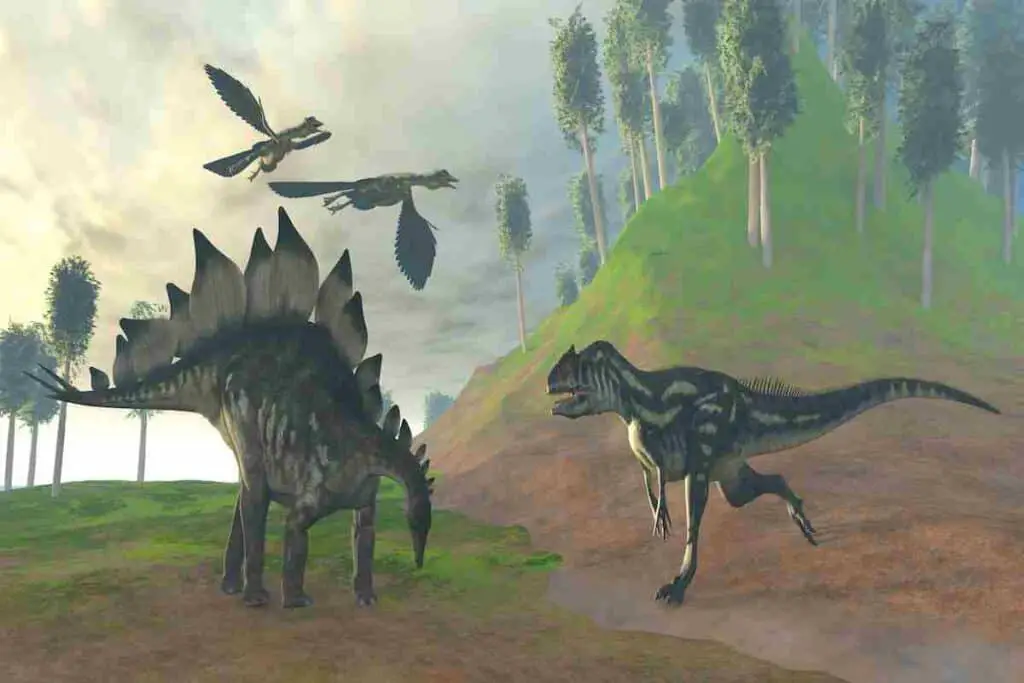The tail is one of the unique parts of most dinosaurs. These dinosaur tails are for many functions which vary from one species to another. Most are for counterbalance and as an essential defense tool against potential predators.

What Were Dinosaur Tail Weapons?
What dinosaurs use its tail as weapons? Herbivorous dinosaurs usually have tails as weapons. Stegosaurus has a thagomizer and Ankylosaurus with a club. These structures are primarily for defense and support in slashing through vegetation.
Defense is such an essential ability if you are a favorite prey of agile predators. In dinosaur times, herbivores were extensively hunted by great omnivores and meat-eaters such as raptors and T-rex.
This event in the circle of life (prey-predator relationship) prompted herbivores to evolve defense traits, particularly their tails.
Table of Contents
Finally, I will discuss the famous dinosaurs with their tails as weapons and the specific structures that make their tails a unique weapon.
Spikes and Clubs: What Dinosaur Uses Its Tail As a Weapon?
Herbivorous dinosaurs or plant-eaters rely on vegetation alone for food and energy. As a result, these herbivore dinosaurs were one of the easy targets of the omnivores and carnivorous dinosaurs, but because of their armor, they were protected.
Structures for Defense: Spikes and Clubs
Spikes and clubs were one of the armors of herbivore dinosaurs used to defend themselves against predators. Fortunately, these weapons were deadly, proven by some injuries in uncovered fossils such as bone cracks.
The presence of these defense structures was commonly present in herbivorous dinosaurs. These herbivores utilized their spiky tail and body for cutting and protection purposes.
One of the herbivore dinosaurs with a spiky body was the nodosaur, with a significant spike in its body and head. Through their spiky body, they can cut through vegetation, or they can use the spikes to harm their predator as a defense.
The Stegosaurus made efforts to use its spiked back, which extended up to the tail, to scare or even kill any predators. In some literature, though, these tails could also be just an ornament for mate attraction.
Another armor or weapon of the herbivores’ dinosaurs was the clubs. Clubs are bony structures in the tail that are also present in some mammals.
However, these are distinct bony structures because interlocking vertebrae form them at the end of the tail. It is mainly found in Ankylosaurus, which they used to scare away their predators. (Source)
According to research, the clubs were only found in adult ankylosaurids. These adults protect their young during vulnerable stages of their life through tail clubs. These modified tails are not uncommon in terrestrial tetrapods (four-legged animals).
Famous Dinosaurs with A Weapon Tail: The Ankylosaurus & Stegosaurus
Four-legged dinosaurs usually use their tails as a weapon like Ankylosaurus and Stegosaurus. Some were also found on two-legged dinosaurs like the Pachycephalosaurus. Four-leggeds can carry spikes, clubs, horns, and plates efficiently because of their bone and muscle support.
These dinosaurs had lived from the Late-Jurassic (Stegosaurus) up to the cretaceous period (Ankylosaurus). These armored dinosaurs were herbivores or plant-eating dinosaurs, which means it is unnecessary to use their spikes and clubs to hunt their prey, for they eat vegetation.
Although herbivorous dinosaurs ate plants, their armor was still useful when omnivorous dinosaurs and other predators attacked them.
Stegosaurus is a famous dinosaur that has been long featured in different books and even part of the dinosaur’s songs for kids. This dinosaur is more adored by girls than boys because of the cute plates on their backs.
The Stegosaurus and Its Thagomizer Tail
Stegosaurus was a large plant-eater of the armored dinosaurs from the family of Stegosauridae. The largest Stegosaurus grew at about 30 feet or 9 meters, known as the Stegosaurus armatus. Yet, the most studied Stegosaurus is the Stegosaurus stenops due to the completely uncovered fossils showing its thagomizer tail.
Stegosaurus was one of the dinosaurs that used tails as their weapon despite the character of being a plant-eater. They used their spiky tails as a defense when some attacked them.
According to the uncovered fossils, their spiky tails were the killer weapon to end predators’ lives. Like the common armored herbivorous dinosaurs, Stegosaurus was studded with plates on their back skin. (Source)
The usual area where their weapon is embedded is their head or back skin. The Stegosaurus’ spiked tail is called a thagomizer. This term was created by the cartoonist Gary Larson in 1982.
The term thagomizer refers to the arrangements of the four spikes on the tails of the Stegosaurus. Then, this informal term was later used by scientists, researchers, and many other experts in referring to the same structure in Stegosaurus. (Source)
Evidence of the Stegosaurus Using Its Powerful Thagomizer
Looking into different Stegosaurus fossils, paleontologists and other scientists noticed the formidable tail, called thagomizer. In 2005, experts found a fossil that shows an Allosaurus harmed by the thagomizer of the Stegosaurus.
Fossil evidence indicates and confirms that the thagomizer was a weapon used to defend itself against massive carnivores like the Allosaurus.
The damage in the Allosaurus fossilized remains “fits well with what would result from a Stegosaur striking under and upwards attack with its spiked tail” that resulted in a fatality. Thus, this served as the concrete evidence for its defense function, which is undoubtedly a good find. (Source)
What Dinosaur Has Balls On Its Tail?
Dinosaur species also have balls on their tails. Not just balls in some but also a body studded with armor during the late Cretaceous period. Below is a herbivorous dinosaur equipped with another armory that is the ball-shaped clubs on their tail.
The Tale of The Ankylosaurus’ Tail
About 66 to 70 million years ago, the Ankylosaurus magniventris roamed North America during the Late Cretaceous era. The body of this herbivorous dinosaur (which is, of course, a four-legged animal) was short and squat, covered with bony plates studded like spikes.
Aside from its bony plates like spikes, its tail has plates that fused to form ball-shaped clubs. Its head was also protected with armor and spikes. It is why Ankylosaurus is called the armored tank of dinosaurs.
Ankylosaurus is one of the famous dinosaurs and the largest Ankylosaurus species, having a total length of 10 meters and weighs about four tons. Since its body was covered by bony plates and its head armored by spikes, Ankylosaurus was protected from predators.
However, these spikes were lacking or reduced in the belly area of the Ankylosaurus, making it a vulnerable point. The predatory ones then targeted this weak spot. Tyrannosaurus rex would flip down this herbivore dinosaur to have full access to its most vulnerable area.
Not all Ankylosaurus had a clubbed tail. For example, the clubbed tail was found intact only in the Ankylosaurus magniventris. This clubbed tail was formed through the fusion of the two plates on its rear, which they can use to swing it off to scare away its omnivore dinosaurs and other predators.
Its clubbed tail resulted from the last vertebrae of its tail, where it was nested tightly opposite from its other bony plates. (Source)
The Strength of the Ankylosaurus Tail
Since discovering Ankylosaurus through fossils, scientists have always wondered how efficient and robust it is as a weapon. It resulted in a series of simulations and experiments to develop a factual finding that will leave us in awe.
The club may be strong because of its structure formed by bone, but researchers suggested that it was not enough to kill a T-rex instantly. Instead, it could have been used to crush bones in the ankles, ribs, and other bones in the enemy’s body in one blow.
Based on a CT scan of several Ankylosaurus species, the dinosaur can achieve a 100-degree lateral swing and generate force enough to crush bone. However, this might not be true for all ankylosaurids since some are small species.
Tail strength is proportional to species body size, so there is also a lesser tail force for the smaller ones. Of course, you would not want to be around when a bigger Ankylosaurus would swing its tail which would surely be a pain for the predator or enemy. (Source)
Conclusion
Tails play a considerable part in the dinosaurs’ life, especially in defense. Stegosaurus’ thagomizers and Ankylosaurus clubs were the first lines of defense and an excellent addition to its armory. In the years to come, let us expect more of it! Having these heavy, bony structures is aesthetically pleasing and fascinating to the eyes and essential to survive.
Recommended Reading:
● I’ve written a whole article about hadrosaurs including the different types and the ones with distinctive head crests which gives a broader perspective on these duck-billed dinosaurs.
● If you are interested in reading more about dinosaur teeth, including hadrosaurs and why scientists speculate hadrosaurs did not feast on hard vegetation, I wrote an article just about this topic.
